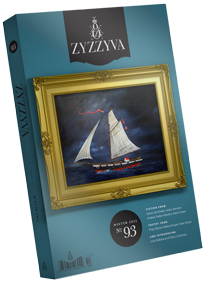
Jackie Bang’s story “Silver Mailbox,” which appears in the Winter 2011 issue of ZYZZYVA, is either a heavily fictionalized piece of nonfiction or a heavily factual piece of fiction. Or perhaps something else. The story of a Washington couple — the Miner and the Collector — and the recently-arrived infants brought into their brood, it’s a stylized piece of writing that leaves you eager to learn of the fates of these strange but compelling people. We talked to Jackie Bang via email about her story and the larger work of hers from which it’s taken.
ZYZZYVA: “Silver Mailbox” is the first story from a work-in-progress of yours. Could you tell me more about this larger work?
Jackie Bang: Yes, “Silver Mailbox” is currently the first story in True Tales of the Incognito Circus, a nonfiction book I’m working on that hopscotches between my humble beginnings and my humble now; it is an anti-memoir (a memoir that challenges the general rules and expectations of memoir), a book that gives equal consideration to the faux-horror film Gremlins and to the origins of certain Mormon doctrine. I think aside from this humility (i.e., the being-poor aspect) what binds all these stories together is the recognition that absurdity might as well be grace.
Z: For the Winter issue of ZYZZYVA, we chose to categorize your piece as fiction, but as you said, it’s part of a work of creative nonfiction.
JB: Well, “Silver Mailbox,” is an origin myth, on the one hand, and on the other a very factual account of my makeshift family’s origins. It has the advantage of this bipolarity. And though I take a certain degree of artistic license with the presentation, I trust my readers to discern what is real and what is not in the piece. I think that whenever a writer presents the in-scene memories of an infant, whether fiction or non–, there is some clear and present creativity at play.
Z: So when a person approaches a work of creative nonfiction, should she be ready to accept that significant parts of what she’s reading are in fact fictionalized? That is, made up or otherwise reworked to illuminate a larger truth, for example, or to otherwise serve the narrative?
JB: You know, creative nonfiction is a pretty squirrely genre, which is why I like it so very much. But in this post-James Frey era — and that woman who pretended to be Native American and raised in a foster home in South Central, or whatever, (wasn’t there also someone who said they’d been raised by wolves? Like, actually? ) — I think that publishers and editors are worried about getting caught in that whole mess of straight-up falsifying. And those concerns are clearly valid just from a credibility stance, never mind the money, potential lawsuits, etc. Also, I think that the bond that a writer of true stories has with a reader is rooted partially in the claim to truth telling. No one wants to feel lied to.
But I don’t think that you can underestimate the role of storytelling itself. Some of the charm of creative nonfiction over journalism or the non-creative essay is the tension between truth and beauty. Anytime you put a memory in scene there’s some craft elements of fiction involved. Was her dress yellow that day, or do you just remember it that way because your brain has supplied that color to the memory over time? Was it rainbow-colored? Do you have a photograph? Do you have video? If not, can you ethically write it? What if she wore that dress frequently but you can’t be sure it was that dress that day? What if you put it in third person? What if someone told you the story? What are the rules then? A reader of creative nonfiction should expect to read fictionalized things, or not; those elements will be there just the same. I think as a genre creative nonfiction is necessarily transgressive, but that implementation of fictional craft elements raises ethical questions, and maybe in addition to making art, that’s the writer’s point.
Personally, what I try to do is stretch the parameters of what can be done, with acknowledgement. And I think that’s pretty crucial. Sometimes you use the word “imagine,” and sometimes the word is implicit. And whereas I have a soft spot for liars, especially bad ones, every woman must have a code that she can live by, and mine is to tell the truth but tell it slant. And also that “crux is core” — but I picked that up from a grown-ass man in Eighties’ jogging shorts circa 2003 who frequented a bar I tended and went by the name of Fast Eddie.
Z: What are the works of creative nonfiction that have shaped your thinking of the genre and what it can be?
JB: Initially, it was Maxine Hong Kingston’s Woman Warrior, and I’d say True Tales of the Incognito Circus is closely linked to that work in terms of formal manipulations. (It made me early on a kind of die-hard formalist.) But I was most moved by Kingston’s invocation of myth and her meditation on ghost stories as lineage. I was also moved by James Baldwin’s angelic yet incisive The Fire Next Time, in which you can feel the sky come tumbling down; whether you believe in God or not, the man was a prophet. Art Spiegelman’s MAUS, for his graphic-artist choices and ever-present accountability; Mary Karr’s The Liars Club, for the courage it took to present her life linearly and for providing the perfect metaphor for the genre as a whole; the essay “Consider the Lobster” by David Foster Wallace, for his incessantly troubling questions about the ethics of “boiling a sentient being alive.” And lastly, the works of gangsta rap artists like Eazy E, DMX, and Tupac Shakur, in concert with Joseph Smith’s Book of Mormon: Another Testament of Jesus Christ. As a group of texts they provide me the opportunity to meditate on the tensile relationship between person and persona. I could go on, but these here are the most likely to drop Billy Lyons at the Bucket of Blood.


Dear Oscar,
Thank you for this interview– my morning bowl filled with vivid porridge.
The sentence, “absurdity might as well be grace” is the knife hidden in the cake.
May you walk on the field of dreams with 2012 romping beside you.
Blossom